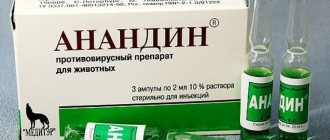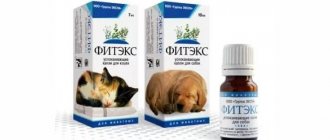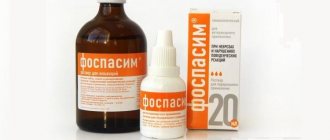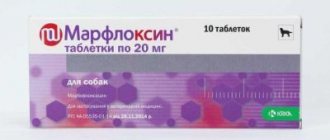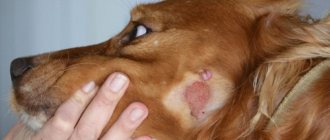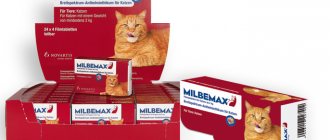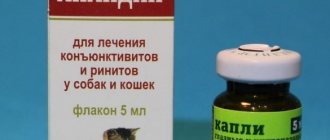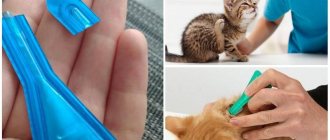Composition and action
Surolan contains several components as active ingredients. The therapeutic effect of the drug is provided by:
- Miconazole nitrate is a synthetic substance that has pronounced antifungal activity, as well as an antibacterial effect against gram-positive microorganisms;
- polymyxin B sulfate is a polypeptide antibiotic that is effective against gram-negative bacteria;
- Prednisolone acetate is a synthetic glucocorticoid that has a strong anti-inflammatory and anti-exudative effect. An additional property of the hormonal component is its antipruritic effect.
Surolan drops have proven effective in the treatment of therapeutic otitis externa, as well as skin diseases in domestic animals caused by the following types of pathogens:
- pathogenic fungi (Candida, Microsporum, Trichophyton and others);
- gram-positive bacteria (streptococci, staphylococci, etc.);
- gram-negative bacteria; microscopic mites of the Otodectes species.
The combined drug has a wide spectrum of antimicrobial and antifungal effects, relieves inflammation, and has an antiallergic effect.
Contraindications
When using the drug in accordance with the instructions, no side effects are noted. Sometimes during treatment, partial hearing loss is possible, which lasts 2–3 days; this effect completely disappears after the end of treatment.
Surolan is well tolerated by most animals and can be prescribed even during pregnancy and lactation.
It is not recommended to use surolan drops for cats and dogs to treat animals with perforated eardrums or allergies to the components of the drug. If an allergy occurs (itching, rash) on the animal’s body, this condition can be relieved by the parallel use of antihistamines.
Storage and precautions
Surolan must be stored in packaged form away from direct sunlight at a temperature of +5 - +25°C. Drops should not be stored together with food. The drug is valid for 2 years; after opening the bottle, the contents must be used within 3 months. Surolan is considered a drug with moderate toxicity. However, in therapeutic doses it does not cause harm to health, so it is dispensed in a veterinary pharmacy without a veterinarian’s prescription.
Purpose
The drug is prescribed by veterinarians for inflammation of the ear canal and dermatological diseases:
- dermatitis;
- pyodermatitis;
- dermatophytosis;
- infected wounds.
Otitis is a common hearing disease in pets, the causes of which may be:
- hypothermia;
- injuries, foreign objects and water;
- tendency to allergic reactions;
- ear parasites;
- other inflammatory agents.
Otitis externa is easily treatable, but if the inflammatory process affects the deeper parts of the ear canal (middle or internal), dangerous complications can develop. With deep otitis, the following are possible:
- swollen lymph nodes;
- hearing loss – partial or complete deafness;
- impaired coordination of movements.
Without treatment, inflammation can spread to the brain, causing paralysis and death.
Typical symptoms of otitis media include:
- itching, which is manifested by the animal’s restlessness and frequent attempts to scratch the sore ear;
- accumulation of syrupy exudate in the ear canal, which often has an unpleasant odor;
- redness, swelling of the sore ear;
- general change in condition – lethargy, loss of appetite.
The pain causes the dog to shake its head, and it increasingly tilts its head to the painful side. At the same time, the general condition of the pet changes - the dog may refuse to eat, walk around sad, and more often lie on the mat.
Treatment is carried out under the supervision of a veterinarian after examining the animal and identifying the pathogen. In this case, antibacterial or antifungal drugs are prescribed, and in difficult cases, hormonal drugs. Surolan drops can be part of complex therapy; they are prescribed if the active components of the drug are effective against this type of pathogen.
The classification of otitis involves dividing the disease by origin (primary - which develops independently, for example, with hypothermia - and secondary, which is a consequence of any pathologies in the body). They differ in localization:
- otitis externa;
- average;
- internal otitis This is the most dangerous type of pathology, in which the cartilage tissue and eardrum are inflamed. It is difficult to treat the disease, in addition, there is a threat of sepsis, and this process can spread to the brain. And this often leads to the death of the animal.
According to the course of the disease, otitis media can be acute (characterized by severe pain, rapid development) and chronic (symptoms are not so pronounced, the disease progresses, periodically exacerbating, then the exacerbation is replaced by a long period of remission until new provoking factors appear).
The nature of discharge from the ear canals can also be different, and based on this, otitis media is distinguished:
- exudative (in which the amount of released sulfur and sebum increases);
- purulent.
The largest classification involves diagnosing otitis according to the causative agent of the disease:
- fungal – has vivid symptoms, characterized by the rapid spread of pathogenic fungi. Treatment should be started as soon as possible, since this particular type of disease is dangerous if it spreads to the internal parts of the hearing aid;
- bacterial - caused by pathogenic microorganisms, accompanied by an increase in temperature, the formation of dry crusts inside the ear canal and auricle;
- allergic – accompanied by redness, itching, swelling of tissues. It often appears not only on the ears, but also on other parts of the body.
Otitis media can be a consequence of a parasitic disease – otodectosis. The invasion is caused by microscopic mites that penetrate the ear canal and move along it, feeding on epidermal cells. The disease is accompanied by severe itching, which causes the dog to scratch its ears until it bleeds, and a secondary infection can enter the body through micro-wounds. Scabs, dark dried crusts in the auricle with otodectosis are waste products of the ear mite.
Surolan has the ability to relieve itching, it prevents the spread of pathogenic microflora, so drops are recommended for ear diseases and are often used as part of complex therapy, which may include antibiotics, anti-inflammatory and antifungal drugs, and in case of tick infestation - acaricidal drugs.
Pharmacological properties and indications for use
Surolan is a combined medication intended for the treatment of not only otitis media in cats, but also fungal and bacterial pathologies developing in the skin area. The main active ingredients of Surolan drops are:
- Miconazole is a synthetic derivative of imidazole (fungicide). Actively affects the membranes of fungal cells, reducing the production of ergosterol and provoking a change in the permeability of some pathogenic bacteria. The activity of miconazole is manifested against dermatophytes and fungi of the genus Candida, Trichophyton and Malasesia.
- Polymyxin B is an antimicrobial substance with a polypeptide structure. It affects the cell membranes of pathogenic microorganisms, causing destruction of their integrity. The activity of the substance is manifested against gram-negative bacteria, such as salmonella, klebsiella, pseudomonas, enterobacteria and E. coli.
- Prednisolone acetate is a glucocorticoid substance obtained synthetically. Local use as part of ear drops can relieve itching, eliminate the inflammatory process and accelerate the regeneration of damaged tissues.
The external use of substances such as miconazole and polymyxin B as part of ear drops for cats allows for an antifungal and antimicrobial effect without affecting internal organs due to low absorption into the systemic bloodstream. Prednisolone enters the bloodstream in small concentrations and subsequently enters the liver structures, being transformed and excreted from the body along with feces and urine.
The drug for the treatment of otitis media in cats, Surolan, is classified as a low-hazard, non-toxic substance. When used correctly, there is no irritation at the site of application and no increased sensitivity of nerve receptors.
Ear drops are prescribed in veterinary clinical practice for cats as part of complex therapy for acute and chronic inflammatory processes in the ear canal area. Surolan is widely used to treat pathological conditions of the skin - dermatitis, pyodermatitis, fungal infections, abscesses and infected wounds. The product works well against fungal and bacterial infections of the skin.
Application
Surolan drops can be used only as prescribed by a doctor - after assessing the animal’s condition and determining the type of causative agent of the disease. Before instilling the medicine, you should carefully clean the auricle and ear canal with lotion. Dirt, purulent contents and scabs and crusts should be removed regularly, up to several times a day, as they deactivate the effect of the medicine and increase inflammation.
The exact dosage and duration of treatment is determined by the veterinarian; the usual single dose is 3-5 drops. You need to drip twice a day until the signs of the disease completely disappear. Only a doctor can stop the drug, but the general course of therapy with Surolan is not recommended to be continued for more than two weeks.
Important!
For otodectosis, Surolan is used in complex therapy to relieve symptoms of inflammation and reduce itching. The medicine is used in the same dosage and according to the same regimen as for otitis media.
Surolan can be used externally - for skin diseases, the medicine is applied to the affected area, having previously removed hair, dead tissue, and pus from it. Lesions should be treated twice a day for no more than 3 weeks. To prevent the pet from licking the medicine, a collar or protective collar is put on it.
Price
The medicine is sold in bottles of 15 and 30 ml. Depending on the form of release and manufacturer, the cost ranges from 714-1074 rubles. This is a fairly expensive medicine. Therefore, many cat owners prefer Surolan analogues, which are cheaper. There are no drugs that are completely identical in composition.
Typically, pharmacies offer customers: Candibiotic. Price: 290-340 rub. Otospectrin. The average cost is 400 rubles. Otibiovin. Price: 400-460 rub. Otidez. Cost 240-300 rubles.
Thus, in comparison with Surolan, the price of analogues is slightly lower. But they do not have such a diverse combined effect.
Analogs of Surolan for getting rid of ear mites
If your animal has ear mites, you can use an analogue of Surolan for ticks in dogs and cats, such as the drug Amitrazine.
This drug is not very desirable for weakened animals, since it is characterized by increased toxicity. However, taking into account what alternatives there are and considering what analogues for the drug Surolan for dogs currently exist on the pharmaceutical market, Amitrazine can be considered one of the most effective analogues. Young dogs should not be afraid to use it. The drug is instilled once a week and repeated every other week. Only two times: the first time to kill living ticks, the second to kill their eggs that have hatched, but have not yet entered the period of maturity, in order to begin laying new eggs.
On the Internet you can find a lot of information on the topic of Surolan ear drops, instructions, price, analogues, and the information is expanding every year, since the pharmaceutical market does not stand still. It may well be that very soon cheaper analogues for the drug Surolan for cats and dogs will be as effective and safe as Surolan, and at the same time much cheaper, which will certainly please all owners of dogs and cats.
Precautionary measures
When using the drug, it is important to adhere to the following precautions:
- unused remains of the drug must be disposed of;
- drops should be kept out of reach of children;
- after instillation, hands should be washed thoroughly with soap;
- In case of contact with the eyes, an allergic reaction from the conjunctiva is possible; do not allow drops to get into the eyes.
Modern analogues of surolan are the following drugs: ordermil, otonazole and otibiovin. Unfortunately, the latter drug does not have an effective effect on otodecosis. In any case, when treating an animal with any medicine, after which the symptoms of the disease do not disappear or worsen, it is recommended to replace it with another one. Treatment for ear mites takes a long time and is not always effective. Often it is necessary to carry out multiple repeated courses of treatment with a drug to which addiction has not yet formed.
Surolan is considered the best drug for the treatment of otodecosis, dermatitis and otitis. Therefore, if you decide to find cheaper surolan analogues for dogs, it is better to abandon them. The effectiveness of surolan is several times higher than drugs similar to it in terms of their mechanism of action. Its price is justified by its effectiveness and results, which cheaper drugs do not have.

